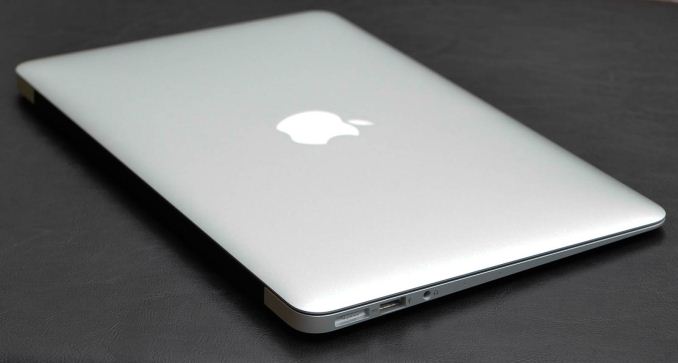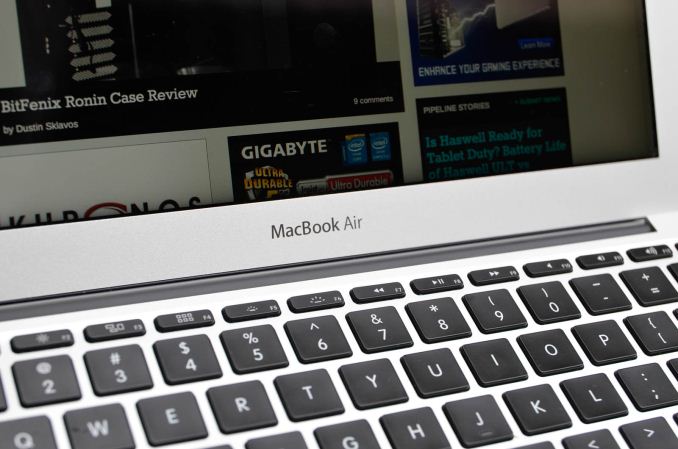The 2013 MacBook Air Review (11-inch)
by Vivek Gowri on August 9, 2013 1:45 AM ESTI come away from the 11” Air with mixed feelings. The modern silicon and generally better specced 2013 model has turned the 11” Air into a far more well rounded notebook than it has been in the past, at least in base $999 form. Unfortunately, the rest of the picture isn’t as rosy. The chassis and especially the display are starting to show their age, even more so than in the 13” Air, and anyone looking for any kind of performance gain over the previous generation is out of luck. The battery life is awesome, it really changes the way you approach the system, and I still love this form factor, but it’s hard to look at this and not compare it to an Ultrabook with a far better display for the same price.
I know Anand has long said that Macs and PCs don’t get cross shopped that often, but recently I’ve been asked for notebook advice by a lot of people who are completely platform agnostic. With the emphasis on web apps, there’s not much holding a normal consumer to one platform or the other unless they have a specific reason (gaming, media creation, familiarity) to ignore one of them. So when you look at something like Sony’s VAIO Pro 11, with a 1080p IPS 11.6” capacitive multitouch display, roughly similar specs (1.6GHz i5-4200U, 4GB, 128GB PCIe SSD), a half-pound lighter body (1.92lbs) with similar dimensions, and roughly the same price point—$1049 street price at the time of writing—it makes you think.
Sure, you lose some of the niceties you get with the new Air—802.11ac, Thunderbolt, the best touchpad in the world (you can’t find another laptop in the world with that combination of things at any price, at least until the next generation of MacBook Pros come out this fall)—and Windows 8 notebooks have never been able to match the battery life of Apple’s notebook line. Sony claims 7 hours of runtime on the 34Wh battery, though it’s worth noting there’s an optional slice battery that adds an extra 35.2Wh of capacity at the cost of a 0.6 lb weight gain. The real question though, how much of the added features would be worth sacrificing for that display upgrade?
On a more global scale, I feel like this is the end of the line for the current MacBook Air chassis. It’s been around for a handful of years now, and I honestly can’t see Apple keeping it around for another go-around. Particularly given how much smaller the Haswell ULT package is and how much less populated the 2013 Air PCB is relative to its predecessors, a sleeker redesign for Broadwell seems inevitable. I’d love to see them get this closer to or even under under the two pound mark without sacrificing the aluminum chassis, because that would really push the boundaries of mobility. I’d like smaller bezels around the LCD as well, though that is more dictated by the size of the keyboard and trackpad than anything else.
Also, it’s clear that something has to give with regards to the displays. I’m not sure when it’ll happen, but it’d be very odd for Apple to continue iterating a thoroughly modern, bleeding edge computer without changing the five year old display panel at some point. Considering all that Apple has done over the years to push notebook displays, it’d be very out of character for them to not address this issue within the next couple of years, particularly as the internal silicon gets so much more power efficient.
Given where this generation of Apple portables has gone, I think the upcoming MacBook Pros will be very interesting. Apple has really prioritized battery life, and the whispers of no dedicated graphics in either MBP makes things very interesting (if a bit concerning from a performance standpoint). If the 54Wh battery in the Air 13” gets to 11 hours of battery runtime without too much trouble, just imagine what the 74Wh battery in the rMBP13 or the 95Wh battery in the rMBP15 can do with Haswell’s power efficiency, particularly if the updated MBP13 gets a single chip 28W Haswell ULT part with Iris graphics. I get chills just thinking about it.
But in terms of the 11” Air, the main point of comparison that needs to be addressed is the 13” Air. I know I covered this in the intro, but it’s worth revisiting. The 13” is without question the better computer, and if you’re looking to replace a laptop, it’s definitely the way to go. I like the 11” Air as a tablet replacement—I’d rather carry this than my iPad on almost every day of the week (unless I need the built-in LTE). It’s almost impossible to use as a primary system though, the way you can with the larger Air. The difference-maker relative to the 13” Air isn’t the weight, since that’s still quite light at 2.96lbs, but the footprint. While the 11” Air is small enough to fit basically anywhere an iPad can be carried, the 13” is much closer to the size of a real notebook. The fact that I’d be making minimal compromises to carry a real notebook versus the iPad is startling, and if you need the most mobile productivity machine you can get, it’s hard to top this. As we start to see more Haswell-based ultraportables and tablets, particularly when the Haswell ULX (Y-series) parts hit, this might change, but for now I feel pretty comfortable saying that.













139 Comments
View All Comments
teiglin - Friday, August 9, 2013 - link
Minor correction: I believe the Vaio Pro 11 has a 31Wh battery (spec page says 4125mAh, pretty sure it's 7.5V).I hadn't realized the Vaio Pro had come down already--and the Sony website is having a most upgrades discounted--only $120 to go from 128->256GB SSD is especially appealing. If you include the rebate, an 8GB/256GB Vaio Pro 11 is only $1250 compared to $1300 for the same configuration of 11" Air. There is certainly an argument to be made in favor of the Air's body over the flexible carbon fiber Vaio Pro, and the Air certainly has the advantage in battery, touchpad, and GT3; in my opinion, though, a 768p TN panel has no place in a $1000+ device any more.
ananduser - Friday, August 9, 2013 - link
GT3 is not all that it could have been since it's hampered by the 15W TDP of the SKU. HD4400 has proven faster in certain areas when paired with a faster CPU than what the MBA sports. I believe Anand showed this in the original MBA13" review.Glindon - Friday, August 9, 2013 - link
If I recall correctly the CPU turbo boost is the same on 4600 and 5000 models. So unless you are using the graphics at full bore the CPUs should be comparable. I'd rather have better graphics.ananduser - Saturday, August 10, 2013 - link
At low frequencies a 300MHz-500MHz increase is noticeable. Again I point to Anand's review of the faster 13" MBA. Thus the CPUs are not comparable and it is this that allows the the HD5000 to underperform in certain areas compared to HD4400.iwod - Friday, August 9, 2013 - link
I would love to get a bigger screen with the Current 11" MBA. Which is still leaving quite lot of bezel space left and right. The Size of 11" MBA is perfect. But Just that slightly larger display would do. The same goes for 13" where it could actually fit in a 13.9" or 14" LCD instead.Other then that, Anand has already covered there are lot of space left in the MBA circuits which means next generation Broadwell CPU will get that redesign along with even bigger battery. Along with better software and Video Decode. So i think the MBA this year is good. The next one is going to be Great.
DesktopMan - Saturday, August 10, 2013 - link
Totally agree about the bezel. Could probably fit a 12 inch display there.EnzoFX - Saturday, August 10, 2013 - link
Of course it can. Since the current display is 11.6". =p
Daniel Egger - Friday, August 9, 2013 - link
Why would Apple want to radically change a proven chassis design? Just because it looks aged? Sorry but that is bollocks. I would even go so far as to say this is by far the best design in the market and as long as no one (including Apple) can come up with a better package they should stay with this one and make incremental changes, like getting rid of the f...ing bezel around the screen and have a matte gorilla glass screen going edge to edge.GekkePrutser - Friday, August 9, 2013 - link
In my opinion it's not that it looks aged, the only thing that looks out of place is the large bezel (especially on the 11")But the problem is that it no longer pushes the envelope. When Apple released the 2010 model it was the smallest and lightest you could buy for the price (not including much lower-specced netbooks).
Now everyone is doing unibodies and they're all at the same point, most of them are doing it better than Apple (e.g. Samsung with their small bezels and better screens). I think Apple should keep pushing forward, and push the 'ultramobile' thing to the max again. I'd love to see something similar to this: http://www.engadget.com/2013/04/19/inhon-blade-13-... a 870g/1.9lbs 13" laptop..
nerd1 - Friday, August 9, 2013 - link
Huge bezel, terrible resolution (and TN screen), heavier than others (compared to series 9 / vaio pro etc which are almost 25% lighter)